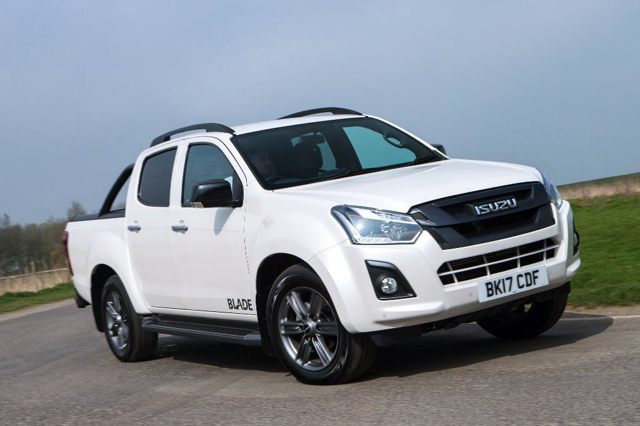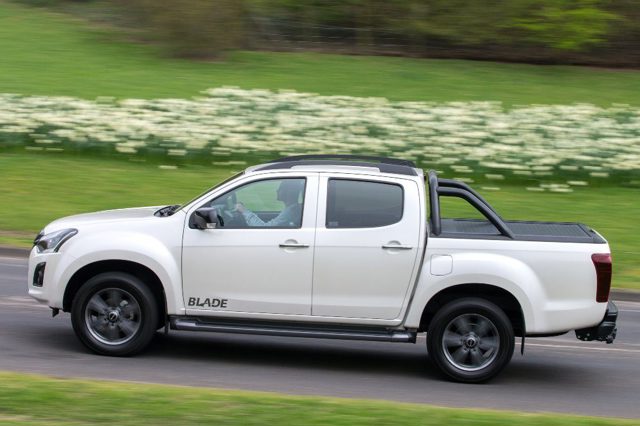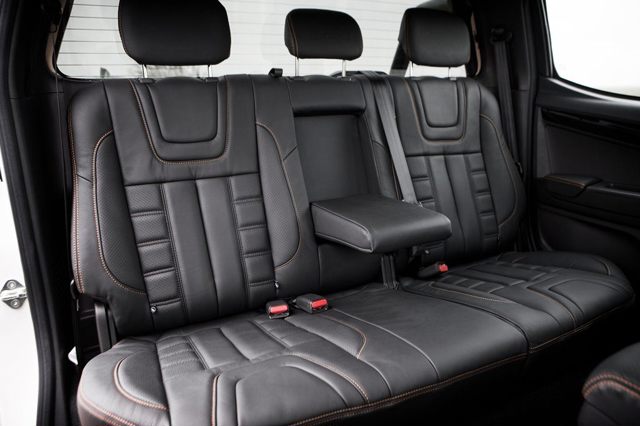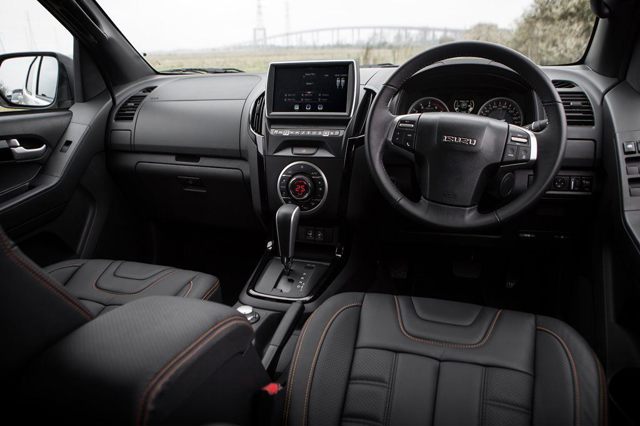Isuzu D-Max (2012 – 2021) Review
Isuzu D-Max (2012 – 2021) At A Glance
The Isuzu D-Max is one of the most capable one-tonne workhorses on the market, pairing low running costs with gargantuan towing ability. Admittedly, it's not the most refined or advanced pick-up money can buy, but when it comes to hauling up to 4.6 tonnes on a budget, the D-Max is difficult to fault.
The Isuzu D-Max was launched in 2012 as the replacement for the Rodeo. Unlike some of its rivals, the D-Max doesn't pretend to be an SUV-aspiring lifestyle vehicle, instead it is pitched as a heavy duty work tool aimed squarely at builders, forestry workers and engineers.
The D-Max is certainly a robust workhorse and can tow up to 3.0 tonnes (extended to 3.5 tonnes from July 2013 onwards). It will also carry a 1050kg - 1136kg payload and can be fitted with a huge choice of bedliners and load covers. There are three body styles to choose from - single, extended or double cab - although it's the double cab that provides the most flexibility, given its large interior and five large seats.
Most models are powered by a 2.5-litre twin-turbo diesel engine with a six-speed manual or five-speed automatic gearbox. The engine delivers 163PS and a whopping 400Nm of torque – from as little as 1400rpm – which provides a lot of low-down pull, through all of the gears. Buyers can choose between two-wheel or four-wheel drive, with the latter providing off-road ability. Claimed fuel economy is 38.7mpg for manual versions, while automatics will provide a claimed 33.6mpg.
In 2017 the D-Max’s 2.5-litre diesel was replaced with a smaller 1.9-litre unit. As before, the four-cylinder engine produces 164PS, but overall torque levels are lower with the 1.9 unit producing 360Nm. However, while the new engine offers 40Nm less torque, the 2017 D-Max retains its 3.5 tonne towing capacity and 1.0 tonne payload.
The D-Max isn't particularly refined on the road; there's lots of engine and road noise, while the leaf sprung suspension pitches heavily in the corners and under hard braking. However, while the ride can be poor at times, the steering is responsive and the 2.5 engine quiets down on the motorway.
The interior isn't the best, with lots of cheap plastics and flimsy materials, but it's practical enough. Everything feels hard wearing and there are plenty of cup holders and pockets. The tough seat fabrics also feel like they’re designed to survive life in a working vehicle.
The D-Max is available in a large choice of trims and can get quite expensive, with the range-topping Blade version breaking the £30,000 barrier when you include VAT. However, if you're planning to use the D-Max for work, then you'd be better with the entry-level versions. Not only are they comfortable, durable and easy to clean, but they also make the D-Max excellent value when you factor in its decent economy and huge load carrying potential.
Looking for the latest model? You'll need our 2021 Isuzu D-Max review.
Driving the Isuzu D-Max (2012 – 2021)
A lusty 2.5-litre four-cylinder turbodiesel with twin turbochargers helps the D-Max offer masses of pulling power almost from tickover. Get the motor spinning and it has all the grunt you could ever want spread between 1500rpm and 3000rpm. With 163PS and 400Nm of shove, the Isuzu makes light work of towing trailers all the way up to its 3.5 tonne maximum and lugging up to one tonne of payload is no problem in the pick-up bed.
It helps that the D-Max comes with a slick six-speed manual gearbox, matching the Ford Ranger on this front, that lets it trickle off the line when you need to make small manoeuvres in tight spaces. Press harder on the throttle and the D-Max displays a turn of speed you might find surprising for a pick-up, though it is accompanied by a fair degree of diesel clatter, so the Isuzu is not quite as refined as the Ranger or Nissan Navara.
However, the D-Max gets back on terms with its rivals when it’s cruising along. Thanks to well chosen ratios, sixth gear in the manual gearbox version of the D-Max means easy, relaxed cruising and the engine is whirring away at low revs at the motorway speed limit. Not only does this mean quiet journeys but also good fuel economy and the D-Max will turn in an official 38.2mpg as a two-wheel drive model. Go for the all-wheel drive version and economy comes in at an identical figure but emissions actually drop very slightly to 194g/km from the two-wheel drive’s 195g/km.
In 2017 the D-Max’s 2.5-litre diesel was replaced with a smaller 1.9-litre unit. As before, the engine produces 164PS and maintains the D-Max's impressive 3.5 tonne towing capacity and one tonne payload. Running costs are lower too, with a claimed 40.3mpg.
If you head off-road in the D-Max, it’s every bit as able and unstoppable as the Ford Ranger or Volkswagen Amarok and it can even give a Land Rover Defender a taste of its own medicine when the going gets very tough. The only limiting factor here is probably whether you worry about minor bodywork scrapes that come with driving in the rough stuff.
Back on the road, the double wishbone front suspension gives the D-Max good bite into corners and a planted feel to the front wheels. The steering is accurate and light, with a decent turning circle adding to the D-Max’s credentials.
However, like its key competitors, caution is needed on slippery roads when the load bed is empty or running light as the leaf-sprung rear suspension can allow the back axle to step out of line. Luckily, the deft steering is more than up to catching any such waywardness and standard ESP means you won’t be left flailing at the wheel.
Isuzu D-Max (2012 – 2021) interior
For business users, the Utility versions of the D-Max are more likely to be chosen and they have cabins trimmed in practical, no-nonsense and easy to clean materials. The Premium versions are more sumptuously trimmed but are no less ruggedly built and their swankier cabins are still pleasingly easy to wipe down and keep free of muck and dirt.
Smaller drivers might find it a bit of a climb into the D-Max’s cabin, but the reward for your efforts is an imposing view in all directions. It’s easy to spot all four corners of the D-Max when there is no hard-top over the load bed, so parking and reversing manoeuvres are simple. This is especially relevant given the D-Max will be used by a lot of owners for towing trailers and horseboxes.
Helping drivers to get into the cab are a number of grab handles, while three drinks holders mean you don’t need to search for somewhere to keep your takeaway latte. There are also plenty of other storage bins, cubbies and boxes all around the D-Max’s cabin.
The driver’s seat has height adjustment and the steering wheel offers limited rake adjustment but no reach movement. Still, finding a good driving position did not prove difficult for us and the D-Max’s driver’s seat is large and well padded. There’s a clear line of sight to the main dials and steering wheel controls for the stereo mean you don’t have to fuss with the miniscule buttons of the rinky-dink stereo. Much better are the large buttons for the ventilation and four-wheel drive selection where it’s fitted.
The gear lever is mounted in the traditional position between the front seats rather than the Ford Ranger’s that is mounted higher on the dash. Still, it’s an easy reach for the driver in the D-Max to the lever and all of the pedals are well weighted and will not test your thigh muscles if you get caught in a traffic jam.
With room for two in the front, the D-Max offers an Extended Cab model for the first time that delivered added storage behind the front seats. This is easily accessed through the rear-hinged mini-doors that meet with the front doors in a clap-hand fashion.
For the Double Cab models, there are front-hinged rear doors that open wide to give a good entrance and exit for rear passengers. Once installed in the rear seats, there’s decent but not brilliant head, leg and shoulder room for adults, but the D-Max can cope with three abreast and there is a trio of three-point seat belts, so it works as a crew cab.
Behind the cab lies a load bed that is a little narrower between the wheelarches than a Volkswagen Amarok but is still more than useful in size and payload. There are securing hooks in each corner and the D-Max can be ordered with additional lashing hooks and a roller cover for greater security. The tailgate drops down to sit flat and flush with the load floor and it’s at a reasonable height from the ground for lifting in heavier goods.
Isuzu D-Max (2012 – 2021) models and specs
| Dimensions | |
|---|---|
| Length | 5295–5313 mm |
| Width | 1820 mm |
| Height | 1685–1795 mm |
| Load Volume | - |
| Miscellaneous | |
|---|---|
| Kerb Weight | 1772–1992 kg |
| Payload | 1036–1136 kg |
| Warranty | 60/120,000 |
| Servicing | 12000 |
Double Cab
| Version | List Price | MPG | |
|---|---|---|---|
| Blade Double Cab 4x4 2.5D | £24,995 | - | Details |
| Blade Double Cab 4x4 2.5D Auto | £25,995 | - | Details |
| Double Cab 4x4 | £16,979 | 38.2 mpg | Details |
| Double Cab 4x4 2.5D | £18,499 | 38.2 mpg | Details |
| Eiger Double Cab 4x4 | £17,729 | 38.2 mpg | Details |
| Eiger Double Cab 4x4 2.5D | £19,249 | 38.2 mpg | Details |
| Eiger Double Cab Auto 4x4 | £18,729 | 33.6 mpg | Details |
| Eiger Double Cab Auto 4x4 2.5D | £19,474 | 33.6 mpg | Details |
| Utah Double Cab 4x4 | £19,729 | 38.2 mpg | Details |
| Utah Double Cab 4x4 2.5D | £21,749 | 38.2 mpg | Details |
| Utah Double Cab Auto 4x4 | £20,729 | 33.6 mpg | Details |
| Utah Double Cab Auto 4x4 2.5D | £21,974 | 33.6 mpg | Details |
| Yukon Double Cab 4x4 | £18,229 | 38.2 mpg | Details |
| Yukon Double Cab 4x4 2.5D | £20,249 | 38.2 mpg | Details |
| Yukon Double Cab Auto 4x4 | £19,229 | 33.6 mpg | Details |
| Yukon Double Cab Auto 4x4 2.5D | £20,474 | 33.6 mpg | Details |
Extended Cab
| Version | List Price | MPG | |
|---|---|---|---|
| Extended Cab 4x4 | £15,979 | 38.2 mpg | Details |
| Extended Cab 4x4 2.5D | £17,499 | 38.2 mpg | Details |
| Yukon Extended Cab 4x4 2.5D | £19,249 | 38.2 mpg | Details |
Single Cab
| Version | List Price | MPG | |
|---|---|---|---|
| Single Cab 4x2 | £13,729 | 38.2 mpg | Details |
| Single Cab 4x2 2.5D | £14,749 | 38.2 mpg | Details |
| Single Cab 4x4 | £15,479 | 38.2 mpg | Details |
| Single Cab 4x4 2.5D | £16,999 | 38.2 mpg | Details |
Model History
- March 2012: Isuzu reveals the all-new D-Max
- May 2012
- August 2012: D-Max awarded a four star Euro NCAP rating
- October 2012
- February 2013
- April 2013
- June 2013: D-Max towing capacity increased by 500kg
- March 2014: D-Max Blade launched
- April 2014: New D-Max conversions available
- July 2014: D-Max Yukon extended cab launched
- January 2015: Heavy Duty Seat Covers for D-Max launched
- August 2015: D-Max Fury launched
- April 2016: Isuzu launched D-Max Arctic Trucks AT35
- February 2017: Updated 2017 D-Max unveiled
- November 2017: D-Max Huntsman Accessory Pack launched
- October 2018: D-Max Fury introduced
March 2012
Isuzu reveals the all-new D-Max
The replacement for the Rodeo range, a new addition is an Extended Cab model. It costs from £14,499 and there are two and four-wheel drive versions.
May 2012
The D-Max makes its debut at the Commercial Vehicle Show. It comes with a five-year, 120,000-mile warranty. The engine is 2.5 litre chain cam 163PS four cylinder with 400Nm torque.
August 2012
D-Max awarded a four star Euro NCAP rating
With 83 per cent adult occupant safety rating , 67 per cent child occupant rating, 51 cent pedestrian rating and 71 per cent for safety assistance systems.
October 2012
Isuzu introduces Vision pack for the D-Max that comes with sat-nav, rear parking camera and upgraded stereo for Yukon and Utah models. It adds £900 plus VAT to the price.
The new unit also features significantly increased audio capabilities, including CD/DVD playback, MP3 compatibility, micro SD, USB, iPod and Parrot Bluetooth hands-free connectivity plus Bluetooth media streaming. Full functionality of steering-wheel controls is maintained.
February 2013
Work and Work Plus accessory packs launched for the D-Max Eiger. The Work pack, which includes a tow bar, a payload liner, front and rear rubber mats and waterproof front seat covers, costs £499 +VAT. The Work Plus pack adds BF Goodrich All-Terrain tyres and is available from £999 + VAT.
April 2013
Isuzu launched a range of accessories available through the dealer network. A stainless-steel rear style-bar is available which runs along the front edge of the load bay. There is al new alloy wheels design, available in 16-inch, 17-inch and 18-inch sizes. The 10-spoke design features an enlarged centre cap and all variants can be shod in heavy-duty off-road tyres.
To improve the security and all-weather practicality there are two new load-bay tonneau covers. A flexible, easy-to-use black vinyl cover features a quick-clamp system. Plus there's an Armadillo roller cover, constructed from ultra-strong aluminium which completely secures the load area with a high-quality dual-action locking mechanism.
A reversing camera and screen kit can be added as an option. The camera is hidden in the rear bumper, and the LCD touch screen integrated into the centre console automatically displays the camera image on the screen when reverse gear is selected.
June 2013
D-Max towing capacity increased by 500kg
All 4x4 models of the D-Max will be able to tow a maximum braked load of 3.5 tonnes, with the new certification applying to all Isuzu D-Max pick-ups registered in the UK from July 1 2013.
March 2014
D-Max Blade launched
The new special edition features more than £5,000 worth of additional equipment and is available from just £24,995 (CVOTR). Styling includes 18-inch, six-spoke ‘Shadow’ alloy wheels with 255/60 R18 Pirelli Scorpion Zero tyres, a ‘Shadow’ grey front grille, privacy glass windows, black door and tailgate handles, black roof bars and rear bumper, plus heavy-duty side steps. Two colours are available - Splash White or mica Cosmic Black.
The Isuzu D-Max Blade also comes as standard with an under-rail bed liner while customers can choose between an Aeroklas hard top complete with internal light or a Mountain Top Black Roller Top Cover which is unique to the Blade and cannot be purchased as a separate accessory.
Inside it comes with automatic climate control and premium black leather seats which have been factory upgraded for 2014 and are heated in the front. It also gets DAB digital radio via a Pioneer 6.1-inch touchscreen navigation system, complete with integrated rear safety camera.
April 2014
New D-Max conversions available
One is a fire response vehicle and the other is fitted with a cherry picker which has been developed for the utility industry, or for tree surgeons. Both of the conversions are built by specialists but will be offered directly through Isuzu Fleet Services.
The D-Max Brigade Response Vehicle (BRV) has a four occupant cabin and is fitted with high-pressure water tanks with a capacity of 310 litres. The tanks are linked to a 55-metre hosepipe with an electric reel. The BRV also features side and rear lockers with roller shutters for storing equipment, plus a high-intensity LED spotlight and emergency response lighting on the front and rear bumpers, front wings and roof.
The D-Max with a mobile elevated working platform (MEWP), more commonly called a cherry picker, is based on the single cab D-Max and features a telescopic boom with a platform. The platform is designed to support 225kg, the approximate weight of two workers and their equipment.
The boom can be rotated 360 degrees and has a maximum height of 13.2 metres, with an outreach of 6.5 metres. The boom can be controlled from the work platform or from the bed of the D-Max itself. All the wiring and hydraulics systems are enclosed within the boom to keep them out of harm’s way, plus there are hydraulic A-frame stabilisers.
July 2014
D-Max Yukon extended cab launched
The extended cab configuration features standard front seats, behind which is a large load area incorporating a fold-down rear bench for occasional use.
The new Yukon specification extended cab – priced from £19,249 (CVOTR) – is ideal for trade and leisure users who prefer the added exterior capacity of a longer rear load bed, require only occasional rear seating, and who still want the interior refinement and equipment available with the Yukon’s specification.
Yukon specification models feature a host of standard equipment, including cruise control, air conditioning, 17-inch alloy wheels, chrome grille and rear bumper, heavy-duty side steps, six-speaker surround-sound audio system with roof-mounted ‘Exciter’ speaker, as well as high-visibility projector headlamps and LED rear light clusters.
January 2015
Heavy Duty Seat Covers for D-Max launched
Work perfectly with the factory-fitted side-airbag deployment, with a large gap in the front, handed covers to allow the bag to deflate without impairment.
Available as either as individual front covers, rear seat only or full set, these covers will keep any Isuzu D-Max interior looking brand new.
August 2015
D-Max Fury launched
Based on the Eiger double-cab model, the special edition costs £19,999 (CVOTR), representing a saving of around £2,000 compared to buying the accessories separately. The Fury is available with either manual or auto transmission.
It gets Magma Red metallic paint finish and 17-inch five-spoke grey alloy wheels with with 255/65 R17 Pirelli Scorpion tyres. Other changes include a dark grey metallic finish to the front grille, Cosmic black door and tailgate handles, a black rear bumper, as well as gun metal grey heavy-duty side steps.
April 2016
Isuzu launched D-Max Arctic Trucks AT35
Available as double-cab or extended-cab, the AT35 is priced from £30,995. In addition to the high levels of standard equipment, a comprehensive accessories list allows customers to spec their AT35 according to their unique requirements.
Arctic Trucks is a vehicle engineering specialist, developing and building 4x4 vehicles able to conquer the most challenging conditions for over 25 years. The Isuzu D-Max Arctic Trucks AT35 is the first Arctic Trucks pick-up in the UK that can be ordered directly from a vehicle manufacturer’s dealer network.
The AT35 retains the one-tonne payload and 3.5-tonne towing (braked) capacities of the D-Max. Suspension is re-engineered with Fox Performance Series shocks, which help deliver increased mobility over even the most rutted tracks and boulders. Special all-terrain Nokian Rotiiva AT tyres endow the AT35 with improved all-round grip in challenging, slippery conditions. These huge 35-inch tyres are specifically engineered for off-road surfaces, with the rubber fitted to 17”x10” wheels, considerably larger than the standard D-Max. The vehicle accommodates larger diameter tyres and boasts wider extended flares, giving the AT35 a securely planted and powerful look.
The combined effect of Arctic Trucks specialised suspension and larger tyres is a ride height 125mm higher than the equivalent standard 4x4 Isuzu D-Max. With the increased ground clearance comes greater approach, departure and break-over angles, capable of tackling the harsh Icelandic terrain or the steep slate slopes of Wales. In addition, drivers and passengers will benefit from improved all-round visibility, a great advantage for identifying the safest route to an ultimate destination, whether that’s across ice fields in Norway or icy moors of north Yorkshire.
Under the bonnet of the D-Max Arctic Trucks AT35 is the highly-efficient 2.5-litre twin-turbo diesel engine that delivers 163PS and 400Nm torque for all models in the D-Max line-up.
February 2017
Updated 2017 D-Max unveiled
There are big changes under the metal, with the D-Max’s old 2.5-litre engine replaced with a new 1.9 turbodiesel. As before, the four-cylinder unit will produce 164PS, but overall torque levels are down, with the 1.9 unit producing 360Nm. However, while the new engine offers 40Nm less torque, the 2017 D-Max retains its 3.5 tonne towing capacity and 1.0 tonne payload.
The model line-up mirrors the old D-Max, with four trim levels and a range of single, extended and double cab bodystyles. The entry-level Utility trim, will be priced from £15,749 and come equipped with LED daytime running lights, hill start assist, hill descent control and Bluetooth.
Yukon (from £20,499 CVOTR) adds 18-inch alloy wheels, silver side steps, new 7-inch multi-function touchscreen, LED rear lights, Cruise Control, rear load liner and a leather steering wheel.
Utah (from £24,149 CVOTR) takes comfort up a notch with keyless entry with push button start, Apple CarPlay and Android Auto, satellite navigation, DAB digital radio, roof bars, leather upholstery with heated front seats, rear parking sensors, automatic air conditioning.
Range-topping Blade models (from £26,999) get tinted windows, nine-inch multi-function touchscreen, remote locking lower tailgate and a colour-coded Aeroklas canopy or sports bar with roller cover. As with the previous generation of Isuzu pick-ups, the D-Max will be covered by a manufacturer-backed five-year/125,000-mile warranty.
November 2017
D-Max Huntsman Accessory Pack launched
The Huntsman features lockable, out of sight storage for firearms as well as ample bed space for dog boxes and equipment.
The new Isuzu Huntsman Pack costs £5995 (excluding VAT) and available on D-Max Utah Double Cab Manual and Automatic variants in Tundra Green, Cosmic Black and Obsidian Grey.
October 2018
D-Max Fury introduced
Finished in Magma Red paint with 18-inch dark grey alloy wheels and radiator grille, the Fury is available with manual or automatic transmission. Inside it has cloth upholstery with a dark grey interior, red stitching on soft pad armrests and steering wheel, manual air conditioning, a reversing camera, 7-inch multifunction touchscreen, CD player and USB ports.



.jpg?width=640&height=426&rmode=crop)
.jpg?width=640&height=426&rmode=crop)





 Powerful 2.5-litre and 1.9-litre diesel engines with 3.5 tonne towing capacity, simple and robust interior, wide choice of bodystyles.
Powerful 2.5-litre and 1.9-litre diesel engines with 3.5 tonne towing capacity, simple and robust interior, wide choice of bodystyles.
 Limited steering wheel adjustment, diesel engine is noisy, ride quality lacks the refinement of its rivals.
Limited steering wheel adjustment, diesel engine is noisy, ride quality lacks the refinement of its rivals.


